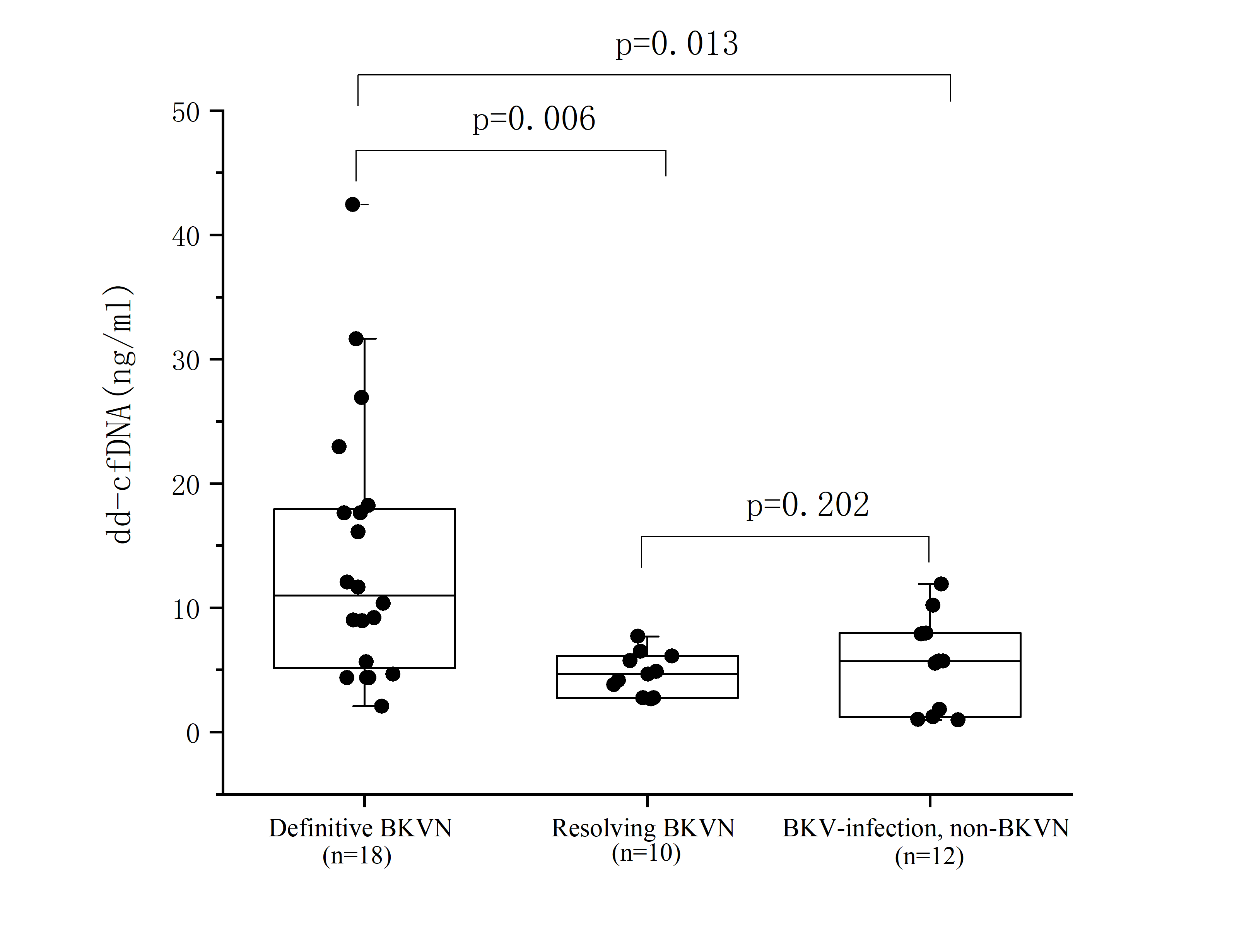Donor-Derived Cell-Free DNA in Urine Identifies BKVN with Graft Injury in BK Viruria Kidney Transplant Recipients
1Organ Transplant Center, The First Affiliated Hospital of Sun Yat-sen University, Guangzhou, China, 2Department of Pathology, The First Affiliated Hospital of Sun Yat-sen University, Guangzhou, China, 3Department of clinical laboratory, The First Affiliated Hospital of Sun Yat-sen University, Guangzhou, China, 4Guangzhou KingMed Center for Clinical Laboratory Co.,Ltd., Guangzhou, China, 5Research and Development, AlloDx Biotech Co.Ltd., Suzhou, China
Meeting: 2019 American Transplant Congress
Abstract number: 532
Keywords: Genomic markers, Infection, Kidney/liver transplantation, Polyma virus
Session Information
Session Name: Concurrent Session: Kidney: Polyoma
Session Type: Concurrent Session
Date: Tuesday, June 4, 2019
Session Time: 4:30pm-6:00pm
 Presentation Time: 5:06pm-5:18pm
Presentation Time: 5:06pm-5:18pm
Location: Ballroom B
*Purpose: BK Polyomavirus nephropathy (BKVN) is an important cause of dysfunction and failure of renal transplants. Elevated levels of donor-derived cell-free DNA (dd-cfDNA) in the urine of renal allograft recipients indicates organ injury. Tubular epithelium infected by BK virus leads to BKVN. The earliest clinical manifestation of BKVN was characterized by BK viruria, especially >107 copies /ml. This study assessed the combined use of dd-cfDNA and BKV DNA loads in the urine to diagnose BKVN.
*Methods: Donor-derived cell-free DNA was assayed in 40 urine samples with paired BKV DNA loads in the urine (>107copies/ml). Eighteen (45%) cases met criteria for definitive BKVN. Ten (25%) cases met criteria for resolving BKVN. Twelve (30%) cases are BKV-infection only (non-BKVN). Performance characteristics of dd-cfDNA for diagnosis of definitive BKVN were determined for samples at graft biopsy, and ddcfDNA quantification through Target Region Capture Sequencing and reads calculated by Maximum Likehood Estimation (MLE).
*Results: The absolute quantification of ddcfDNA in 40 urine samples is 7.9±5.5 ng/ml. The mean level of absolute quantification of ddcfDNA (14.35ng/ml) in definitive BKVN group is significant higher than in resolving BKVN group (4.90ng/ml, P=0.0056) and non-BKVN group (6.44ng/ml, P=0.025). But there is no significant difference between resolving BKVN group and non-BKVN group (P=0.202). There was not significant difference observed in application of relative ddcfDNA quantitative method. There is no difference in urinary BKV loads among 3 groups (median 2.9×108 vs 3.5×107 vs 1.4×108 copies/ml, P=0.284). Plasma BKV loads in definitive BKVN group (median, 3000 copies/ml) is significantly higher than resolving BKVN group (median, 0 copies/ml, P=0.015) and non-BKVN group (median, 0 copies/ml, P=0.003). Mean serum creatinine level in definitive BKVN group (223.5±114.9 μmol/L) is slightly higher than resolving BKVN group (182.9±70.9 μmol/L, P=0.186), but is significantly higher than non-BKVN group (130.7±39.4 μmol/L, P=0.014). The receiver operating characteristic analysis by combining urinary dd-cfDNA and BK viruria (>107copies/ml) reveals that the optimal cut-off is 10.2 ng/ml to detect BKVN, with high sensitivity (55.6%), specificity (92.3%), and area under the ROC curve (0.759).
*Conclusions: The combined use of absolute quantification of dd-cfDNA and BK viruria (>107copies/ml) testing may improve the noninvasive diagnosis of definitive BKVN in kidney transplant recipients. Patients with dd-cfDNA+/ BK viruria (>107copies /ml) have a high probability of definitive BKVN.
To cite this abstract in AMA style:
Huang G, Chen X, Yang S, Chen W, Chen P, Hou X, Jiang T, Liu H, Li X, Wang C. Donor-Derived Cell-Free DNA in Urine Identifies BKVN with Graft Injury in BK Viruria Kidney Transplant Recipients [abstract]. Am J Transplant. 2019; 19 (suppl 3). https://atcmeetingabstracts.com/abstract/donor-derived-cell-free-dna-in-urine-identifies-bkvn-with-graft-injury-in-bk-viruria-kidney-transplant-recipients/. Accessed December 21, 2025.« Back to 2019 American Transplant Congress

